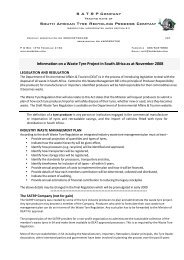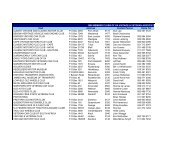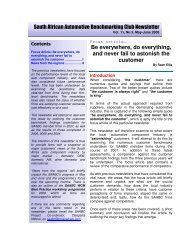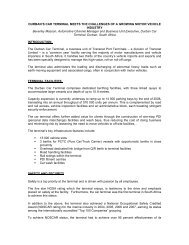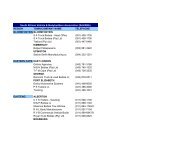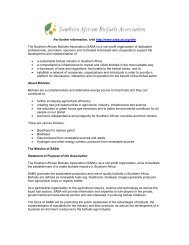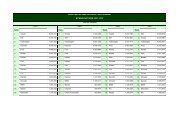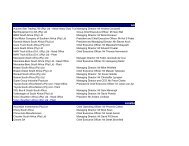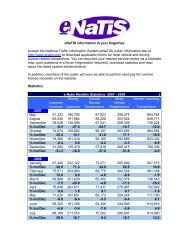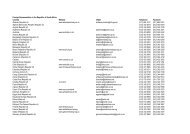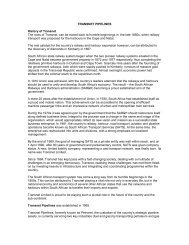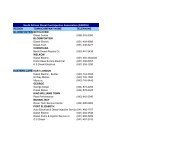Toyota South Africa Sustainability Report 2008 - Automotiveonline ...
Toyota South Africa Sustainability Report 2008 - Automotiveonline ...
Toyota South Africa Sustainability Report 2008 - Automotiveonline ...
Create successful ePaper yourself
Turn your PDF publications into a flip-book with our unique Google optimized e-Paper software.
<strong>Sustainability</strong> <strong>Report</strong>_14-10-<strong>2008</strong>:Layout 1 10/14/08 2:44 PM Page 17<br />
WASTE WATER: PRODUCTION<br />
No waste is shipped internationally, and all hazardous waste is collected by a registered<br />
waste disposal company. In FY’06 a total of 2,120 tons of hazardous waste were disposed<br />
of. This decreased to 1,844 tons in FY’07. The hazardous waste is taken to registered<br />
disposal sites.<br />
In 2007, <strong>Toyota</strong> launched an Internal Recycling Project at its marketing offices in<br />
Sandton, Johannesburg in which staff were encouraged to start sorting waste and<br />
recycling at home, and to bring the resultant recyclable waste to the office. Since the<br />
launch of the ‘Waste from Home’ campaign, employee recyclable waste contributions<br />
average around 200kg per week.<br />
kl/u<br />
5<br />
4<br />
3<br />
2<br />
1<br />
0<br />
FY’04 FY’05 FY’06 FY’07<br />
Actual 3.43 2.89 3.21 2.87<br />
Our waste recovery efforts do not only focus on materials. In the Paint Line, hot gas<br />
from the burners gets captured and sent back to the ovens. This recirculation of hot air<br />
significantly reduces energy consumption in the Paint Line.<br />
We also concentrate on reducing water use through recycling of waste water. From<br />
2006 to 2007, waste water from the TSM Main Waste Water Treatment Plant reduced<br />
by 11% (from 3.21 kl/u to 2.87 kl/u).<br />
In 2006, the waste water treatment plant was upgraded and capacity was increased to<br />
accommodate the increased production arising from Paint Line 3. The upgrade was in<br />
order to achieve the waste water quality requirements set by the municipality, and the<br />
treatment plant was designed to meet 50% better than legal requirements. The waste<br />
water treatment plant has a maximum output capacity of 120m 3 per hour, and currently<br />
runs at an average of 60% of its capacity.<br />
Water<br />
In <strong>South</strong> <strong>Africa</strong>, the 30 th driest country in the world, reducing water consumption is key<br />
to <strong>Toyota</strong> <strong>South</strong> <strong>Africa</strong>’s sustainability.We draw water from the eThekwini municipality<br />
that supplies more than three million people. Following the increase in consumption<br />
due to the introduction of Paint Line 3, our water use has started to decline again.<br />
Our water usage and waste water increased in FY’06 because we were running two<br />
paint lines. This impacted on consumption per unit which has stabilised since the close<br />
of Paint Line 2.<br />
WATER USAGE: PRODUCTION<br />
kl/u<br />
8<br />
6<br />
4<br />
2<br />
0<br />
FY’04 FY’05 FY’06 FY’07<br />
Actual 5.34 4.64 6.99 6.70<br />
<strong>Sustainability</strong> <strong>Report</strong> <strong>2008</strong> 17



